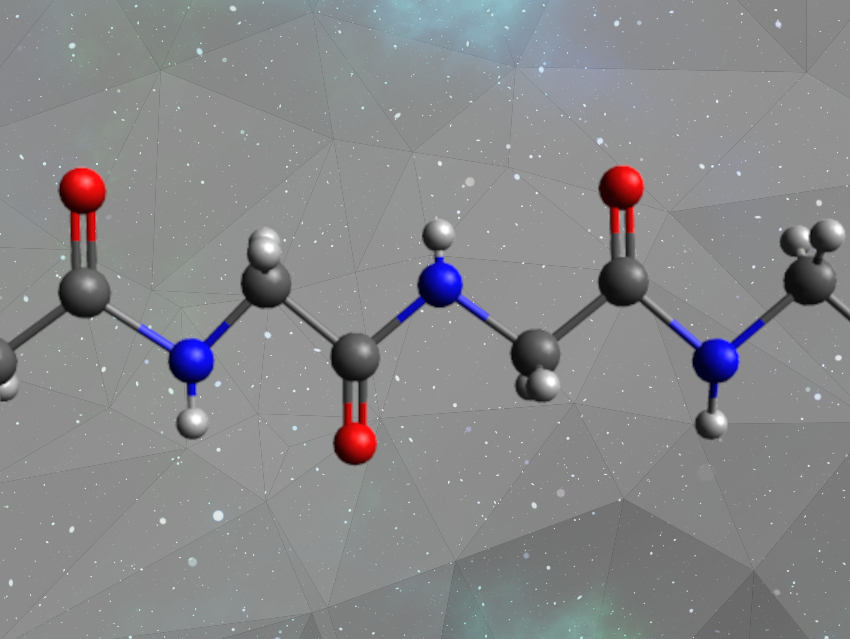Could life have an extraterrestrial origin? Many scientists believe that some of the components essential for life were brought to Earth from space. Sergiy A. Krasnokutski, Friedrich Schiller University Jena, Germany, and Max Planck Institute for Astronomy, Heidelberg, Germany, and colleagues have shown that even organic polymers could potentially be formed in an extraterrestrial environment. The team has discovered that a polyglycine polymer can form in two steps from ammonia, carbon monoxide, and carbon atoms when they come together on a substrate that replicates the cold conditions of cosmic dust particles.
Building Blocks in Meteorites
Three and a half billion years ago, young Earth experienced a period of heavy bombardment by comets and meteorites. Scientists exploring the question of the origins of life believe that this period also saw the transition from abiotic chemical reaction networks to the first life-sustaining biochemical reactions. Astrochemists have identified hydrocarbons, small sugars, amino acids, and nucleobases in comet dust and meteorites, proving that some simple building blocks for life are not exclusive to Earth, but can be formed in space, as well.
However, life cannot exist without organic polymers, which carry both information and functions. Unlike the simple building blocks, these biopolymers are very difficult to build without enzyme catalysis and have not been found in objects from space.
Despite this, the researchers have now challenged this assumption that biopolymers cannot be created elsewhere. They questioned what makes nonterrestrial amino acid polymerization so difficult in the first place. Amino acids dimerize by condensation, that is, they form an amide bond by expelling a water molecule. This process requires energy, lacking in the cold environment of cosmic dust clouds. This knowledge led the researchers to consider an entirely water-free pathway leading to a peptide polymer, starting from aminoketene as the monomer. This molecule, which is akin to dehydrated glycine, polymerizes by addition rather than condensation reactions.
Free Reactants
The team set up an experiment mimicking the conditions in cosmic dust, using reactants thought to be present in these conditions. In a ultrahigh vacuum chamber just above absolute zero, they co-deposited the reactants carbon monoxide, low-energy carbon atoms, and ammonia on surfaces composed of potassium bromide, which served as a substrate. IR spectroscopy then revealed the formation of aminoketenes with the formula O=C=CmNHn.
The researchers propose two subsequent addition reactions as a mechanism, neither of which requires extra energy: First, a single carbon atom adds to the carbon monoxide to form a ketene moiety, then ammonia attaches to this ketene with a subsequent hydrogen shift forming the aminoketene.
The researchers then slowly raised the temperature and found a solid residue, characterized by mass spectrometry as a glycine polymer. However, these polymers were not “real” polyglycine: Instead of a COOH end group typical for peptides, they either carried NH2 groups at both ends or one end was occupied by NH2 and the other by a CH2 group.
Extraterrestrial Polymerization Pathway
The researchers introduce these reactions as a possible extraterrestrial pathway to biopolymers. The key components of this pathway are relinquishing water as a condensation byproduct and the using atomic carbon to generate the monomer. The researchers also propose that the resulting peptides could be incorporated in bulk solids through accretion, where they would then be shielded from destructive cosmic rays.
Many scientists also believe that, with a lot of luck, peptides locked up in meteorite or comet material could survive the journey through Earth’s atmosphere and the impact with Earth’s surface. If such extraterrestrial input of biopolymers occurred, it could have enriched the abiotic chemical networks that were present at life’s beginning. However, polyglycine has not been discovered in any space object to date. The researchers just suggest it could be possible.
- A pathway to peptides in space through the condensation of atomic carbon,
S. A. Krasnokutski, K.-J. Chuang, C. Jäger, N. Ueberschaar, T. Henning,
Nat. Astronomy 2022.
https://doi.org/10.1038/s41550-021-01577-9




